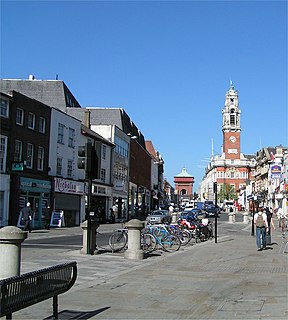Southern Army was a home service formation of the British Army during the First World War, responsible for the defence of South-East England, including both sides of the Thames Estuary.

The Thames Estuary is where the River Thames meets the waters of the North Sea, in the south-east of Great Britain.
It was formed on 11 April 1916 under the command of Sir Arthur Paget, with headquarters at Brentwood, Essex. [1] [2] The Army was composed of 2nd Cyclist Division, 65th (2nd Lowland) Division, 66th (2nd East Lancashire) Division, 67th (2nd Home Counties) Division and six provisional brigades (1st, 2nd, 7th, 8th, 9th and 10th), with 1st Mounted Division attached for training purposes. [3]

Brentwood is a town in the Borough of Brentwood, in the county of Essex in the East of England. It is located in the London commuter belt, 20 miles (30 km) east-north-east of Charing Cross, and near the M25 motorway. Latest figures suggest the town has a population of 79,000.
The 65th Division of the British Army was a second-line Territorial Force division, formed in 1914, which served on home defence duties during the First World War.
The 2nd Home Counties Division was a 2nd Line Territorial Force division of the British Army in World War I. The division was formed as a duplicate of the 44th Division in November 1914. As the name suggests, the division recruited in the Home Counties, particularly Kent, Middlesex, Surrey and Sussex. In August 1915, in common with all Territorial Force divisions, it was numbered as 67th Division. Between September 1917 and the end of the year, the division was extensively reorganized and lost its territorial identity; henceforth it was known as 67th Division.
66th (2nd East Lancashire) Division was established around Colchester. Its training was disrupted by the need to provide large drafts of reinforcements to the British Expeditionary Force (BEF) on the Western Front. However, it finally received embarkation orders in February 1917 and left for France. [4]

Colchester is a historic market town and the largest settlement within the borough of Colchester in the county of Essex. Colchester was the first founded Roman city in Britain, and Colchester lays claim to be regarded as Britain's oldest recorded town. It was for a time the capital of Roman Britain, and is a member of the Most Ancient European Towns Network.
The British Expeditionary Force (BEF) was the British Army sent to the Western Front during the First World War. Planning for a British Expeditionary Force began with the Haldane reforms of the British Army carried out by the Secretary of State for War Richard Haldane following the Second Boer War (1899–1902).

The Western Front was the main theatre of war during the First World War. Following the outbreak of war in August 1914, the German Army opened the Western Front by invading Luxembourg and Belgium, then gaining military control of important industrial regions in France. The tide of the advance was dramatically turned with the Battle of the Marne. Following the Race to the Sea, both sides dug in along a meandering line of fortified trenches, stretching from the North Sea to the Swiss frontier with France, which changed little except during early 1917 and in 1918.
71st Division moved into Essex in early March 1917 and concentrated at Colchester where it came under command of Southern Army. It took over responsibility for the defence of the East Coast from Mersea Island to Walton-on-the-Naze. [5]
71st Division was a short-lived infantry division of the British Army during the First World War. It served in the Home Defence forces and never went overseas.

Essex is a county in the south-east of England, north-east of London. One of the home counties, it borders Suffolk and Cambridgeshire to the north, Hertfordshire to the west, Kent across the estuary of the River Thames to the south, and London to the south-west. The county town is Chelmsford, the only city in the county. For government statistical purposes Essex is placed in the East of England region.

Mersea Island is an island in Essex, England, in the Blackwater and Colne estuaries to the south-east of Colchester. Its name comes from the Old English word meresig, meaning "island of the pool". The island is split into two main areas, West Mersea and East Mersea, and connected to the mainland by the Strood, a causeway that can flood at high tide.




